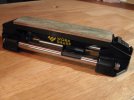+1 for cleaning rods with BKF/Comet/Ajax and a Scotch Brite pad. That’s actually the recommendation from Spyderco.
I’ve tried pretty much the whole gamut with sharpening. I started with a Lansky, then went through sandpaper on plate glass (scary sharp method), waterstones, Norton Crystolon, and probably a few others that I forgot. I’ve kinda settled on DMT plates, freehand, as my preferred method. I also have a Spyderco Double Stuff ceramic stone that puts great edges on my wood carving blades. I have a few strops, and for an EDC or working knife, I’ll often sharpen to DMT fine (600), give it a few stropping strokes on the leg of my Carhartts, and call it done.
Truthfully, the Sharpmaker and similar crock stick systems are probably the easiest way to keep a usable edge on a knife. If you really use a knife a lot, you will eventually get into edge thickening issues with the 20 degree microbevel system, and the “back beveling” at 15 degrees often takes quite some time on modern, wear resistant steels, but for most folks, unless you’re using the knife really often and pretty hard, an occasional touch up on the rods will keep the blade working for a good long time.
I prefer to be able to lower edge angles from the factory, as they almost always come in too obtuse to take full advantage of the steel’s cutting ability, and that is accomplished much more quickly with freehand methods, or with much more expensive systems, which are beyond my means.
BTW, I learned most of the useful stuff I know about sharpening from the Maintenance subforum. There are some guys over there who really know their stuff, and who are happy to share knowledge.

